Disclaimer: This blog post contains affiliate links. If you make a purchase through these links, I may earn a small commission at no additional cost to you. Learn More. Thank you for supporting our garden community.
The Best Cucumber Fertilizer Tricks to Grow Juicy Cucumbers
If your cucumbers are yellowing, stunted, or just not producing the way they should, chances are your fertilizing game needs a tweak. And no—dumping more Miracle-Gro isn’t the answer. That’s not going to do any good for your garden in the long run. So stay tuned for the best organic cucumber fertilizer that’ll supercharge your plants.
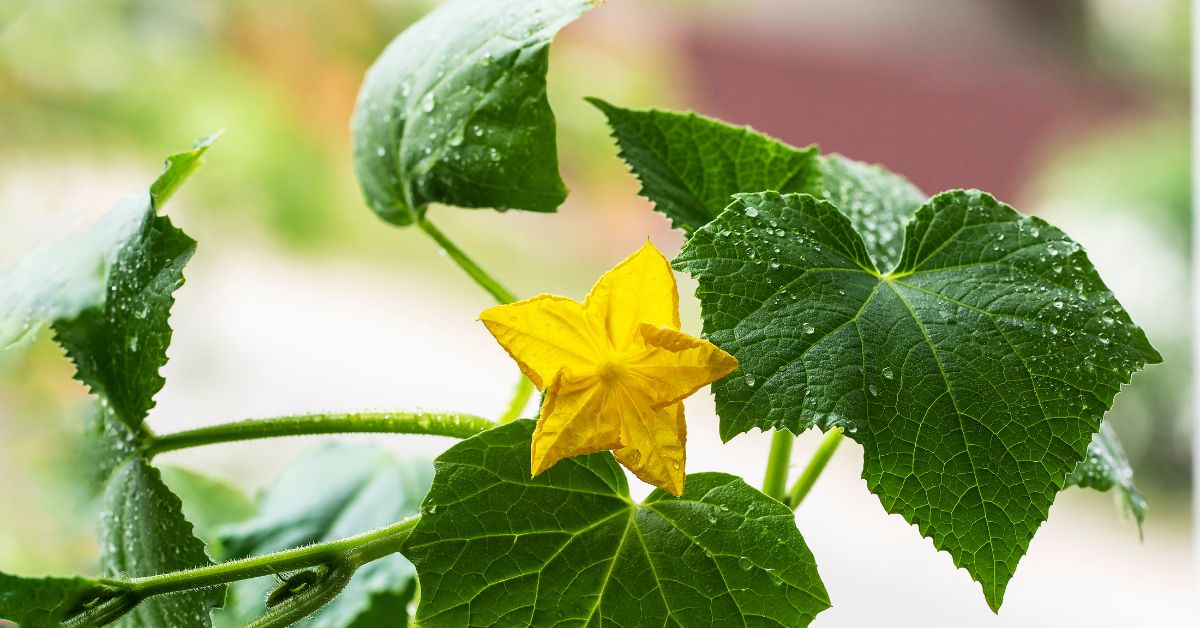
The Best Cucumber Fertilizer Tricks
Fertilizing cucumbers doesn’t have to be difficult, because it really isn’t.
But it’s also not as simple as some artificial gardeners like to tell you. Dumping a bunch of lab-formulated synthetic fertilizers won’t actually give you a good harvest.
There is some nuance, but it’s simple enough where any beginner cucumber gardener can do it.
And I’m going to show you all the tips and tricks to find the best cucumber fertilizer and fertilize your cucumber plants effectively.
That being said, let’s get right into the best cucumber fertilizer tricks to grow juicy cucumbers.
Products:
Save 10% on your first Burpee seed order using code BURPEE10
What Nutrients do Cucumbers Need? (Cucumber Fertilizer Requirements)
Cucumber plants are heavy feeders, meaning they need a lot of nutrients to grow properly. If you don’t give them enough macro and micronutrients, then they won’t give you a good harvest.
But you can’t just throw in a bunch of each nutrient, you have to understand what nutrients cucumbers need. Here are the 3 main macronutrients for cucumber plants:
- Nitrogen (N): Nitrogen is mainly used for leaf and stem growth, especially with cucumbers. Those large leaves are going to need a ton of nitrogen to grow fast and vigorously.
- Phosphorus (P): Phosphorus is mainly used for root and flower production. Strong roots and lots of flowers means you’ll get more fruits that are healthier and juicier.
- Potassium (K): Potassium is used mostly for fruit development, but also for overall plant health. If you want a ton of tasty fruits, make sure your cucumber plants get enough potassium.
These nutrients are used in the greatest abundance by cucumber plants. They are in the greatest quantity in the soil and feed your plants the most.
As for the micronutrients, they are all needed, but in smaller amounts.
These include calcium, magnesium, boron, iron, zinc, and sulfur.
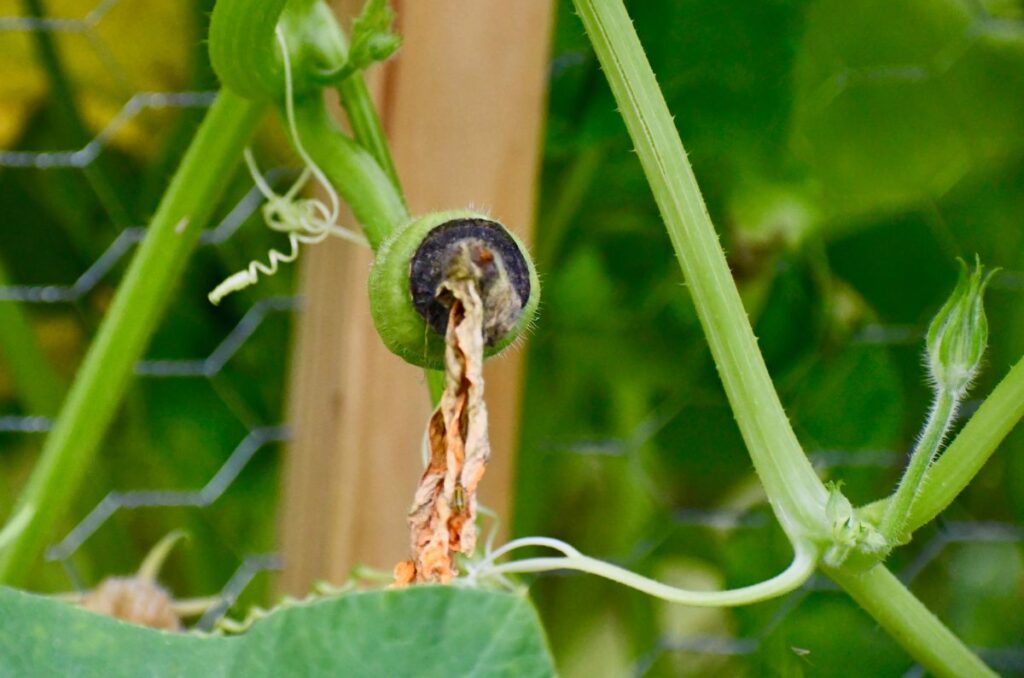
The most important one out of these is probably calcium. It supports healthy fruit development and helps to prevent blossom end rot.
As for the other micronutrients, they’re mainly for overall plant health and physiological functions.
Best Cucumber Fertilizer NPK
NPK stands for nitrogen, phosphorus, and potassium, with the letters being the symbols of each element on the periodic table.
There’s an NPK ratio on every commercial fertilizer package.
It indicates the percent by weight of each macronutrient in a fertilizer. For example, a fertilizer with an NPK ratio of 9-8-7, has 9% nitrogen, 8% phosphorus, and 7% potassium by weight.
The rest of the 100% is made of fillers to bulk up or dilute the fertilizer so it’s not extremely potent.
It’s hard to give an exact NPK ratio for cucumbers. Some people say the best cucumber fertilizer is 3-4-6, others say 2-3-6, and some say 10-10-30.
But I can’t give an exact number because it depends on your soil and how your plants are growing.
Cucumber plants need varying amounts of each nutrient depending on their growth stage.
For example, young plants are not focusing on flower development, only growing new roots and leaves. So it wouldn’t make sense to give them a bunch of potassium right away.
Basically, it depends on the time that you’re fertilizing. And we’ll get into that later on in this article.
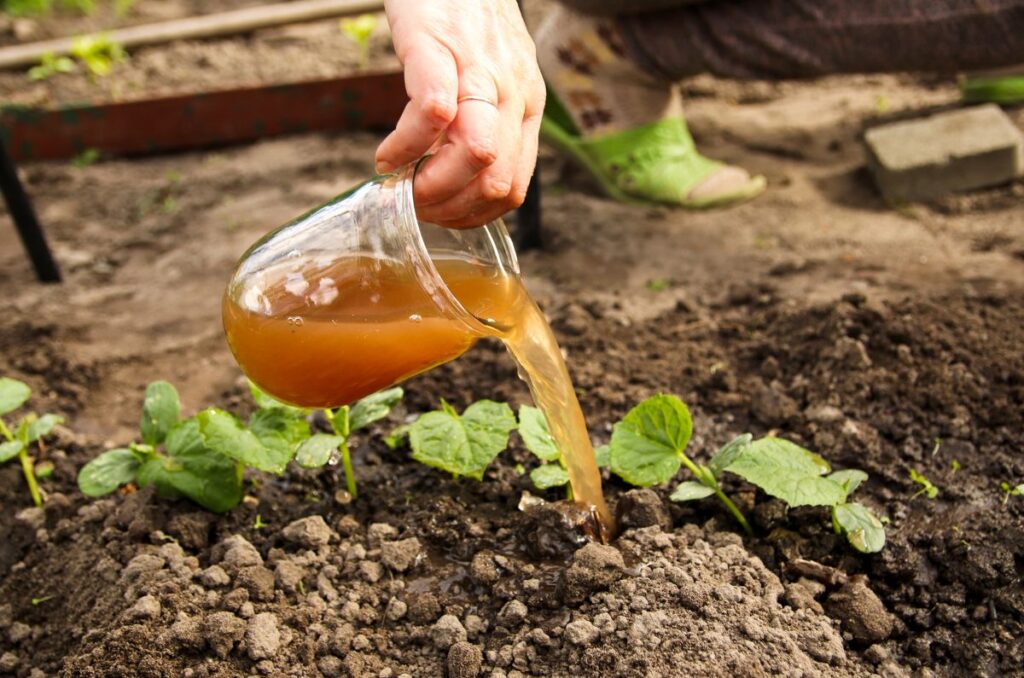
Are Organic or Synthetic Fertilizers Better for Cucumbers?
With absolutely no bias, organic fertilizers are always better than synthetic fertilizers.
But in all honesty, synthetic fertilizers just don’t do it for me, and they probably won’t for you either. They’re just not ideal for the vegetable garden, especially plants that you want to actually eat from.
Yea, it’s true that synthetic fertilizers are cheaper and work quicker. But are we looking for the easy way out or do we want a better cucumber harvest?

It’s also true that synthetic fertilizers contaminate water, acidify the soil, burn your plants, and decrease biodiversity in your soil.
Organic fertilizers, on the other hand, have none of these problems. They’re actually much better for your soil.
They promote biodiversity, are usually sustainably-sourced, don’t acidify the soil or burn your plants.
So always choose organic fertilizers over synthetic and you’ll have healthier and happier cucumbers.
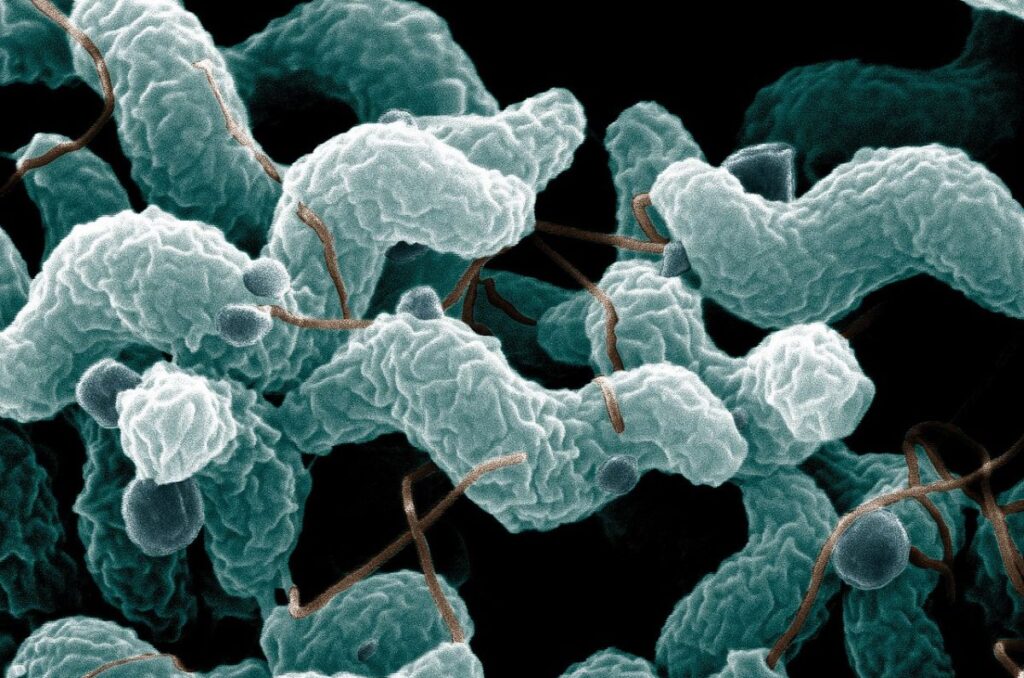
Why Soil Microorganisms are Important
Synthetic fertilizers don’t need soil microorganisms to become bioavailable to your plants. They are isolated forms of the nutrients and are readily available to cucumber plants.
Organic fertilizers, on the other hand, need soil microbes to break them down in order for the nutrients to become bioavailable to your plants.
If they’re not broken down by microbes, then your cucumber plants won’t be able to absorb them.
Therefore, when you fertilize your cucumbers, they can’t get the actual nutrients right away. It needs to be broken down first.
So we need these microbes in our garden soil to do the heavy lifting when it comes to fertilizing.
Generally speaking, if you keep a healthy organic garden, you’ll have a ton of microorganisms in your soil already.
But you can increase their numbers by using homemade compost, compost tea, and mulch. These help to introduce new microbes and increase their numbers.
Add compost and mulch at the beginning of the growing season, and use compost tea periodically while your plants are growing.
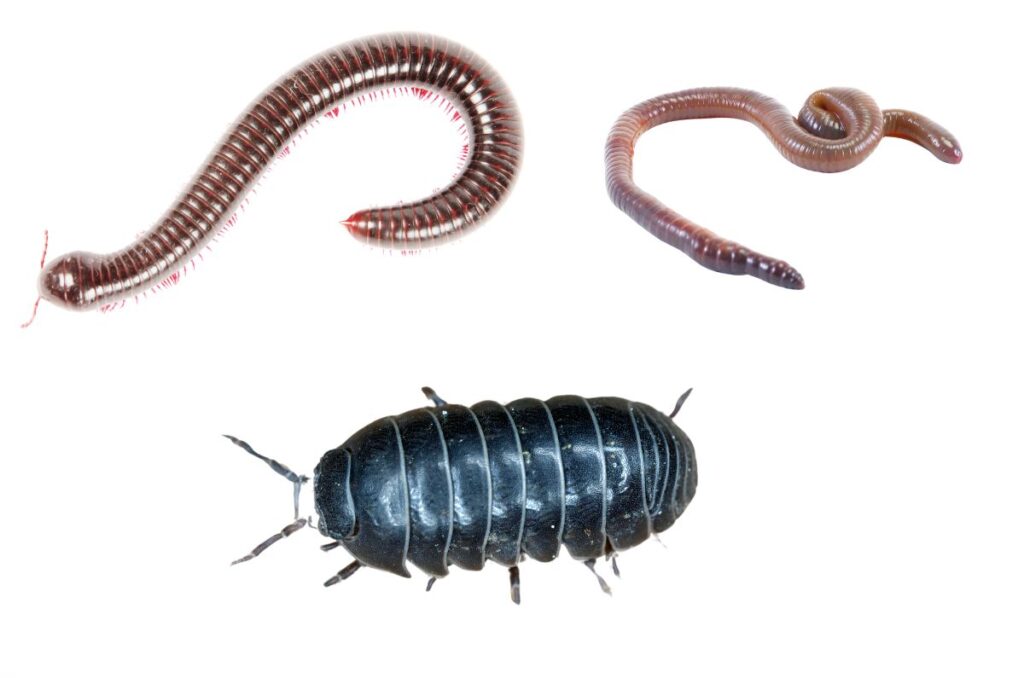
Importance of Soil Macroorganisms
Some macroorganisms, like worms, potato bugs, and millipedes, also break down organic matter.
Macroorganisms are basically just large organisms; so really they’re just organisms. But they mostly break down the larger particles, like leaves, twigs, and other big pieces.
Microorganisms can only really break down matter on the molecular level because they’re so tiny.
So it’s important to have a healthy mix of both types of organisms in your soil.
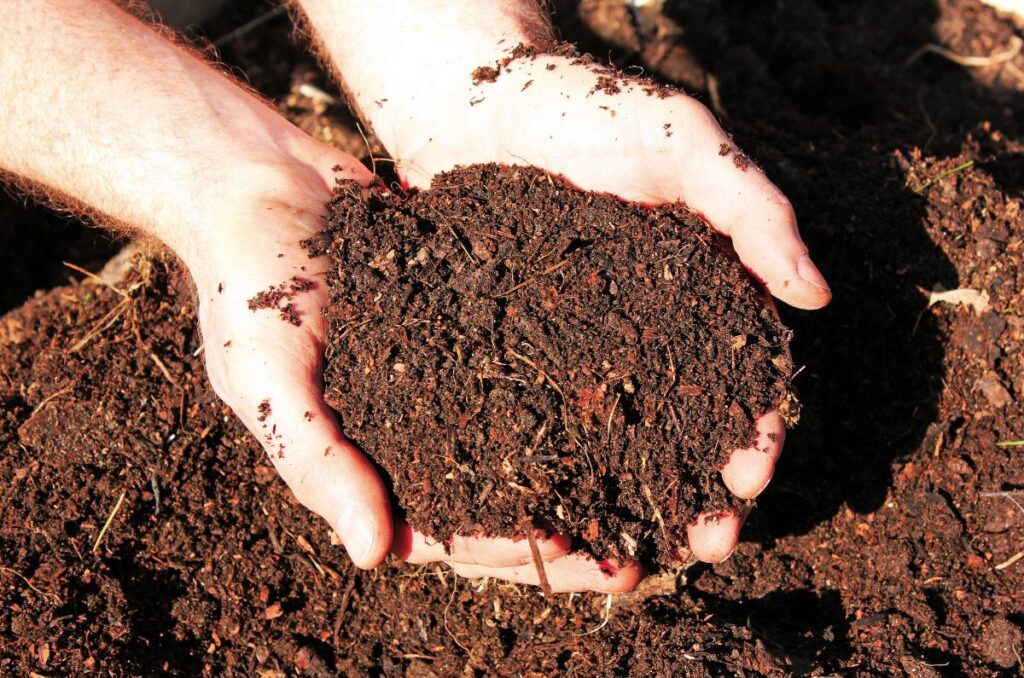
Is Compost a Good Fertilizer?
While compost is technically an organic fertilizer, its NPK ratio is usually really low, like 1-1-1 or lower.
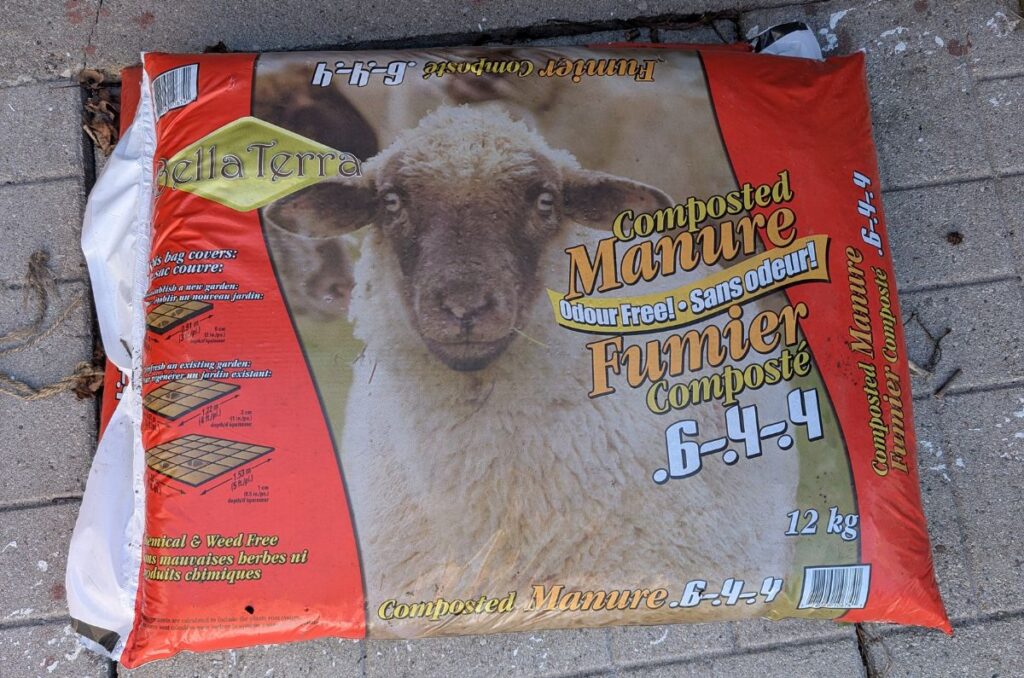
The same goes for manure. I just bought some sheep manure last week and the NPK ratio was 0.6-0.4-0.4, so it was really low.
So it won’t be able to provide all the nutrients that your cucumber plants need.
However, it’s still a valuable amendment for your garden. The main reason to use compost is that it adds organic matter and beneficial soil microorganisms.
It improves the soil structure, water retention, nutrient retention, and biodiversity. But it doesn’t really add nutrients in large quantities.
So yes, we should still use compost, but it doesn’t replace supplemental organic fertilizers.
Liquid vs Granular Fertilizer for Cucumbers
There are 2 main types of fertilizers that you can use for your cucumbers, each with their own benefits.
I tend to use a mix of both during the growing season, but you can decide based on your needs.
Granular Fertilizers
These fertilizers are made by dehydrating and grinding a material, making it into a powder like flour.
And they’re easy to apply as well. Just open the pack and sprinkle some fertilizer on your soil. Water it in and you’re good.
I mean, there are instructions on the back, but who reads that anyway?
Additionally, granular fertilizers release their nutrients over a longer period of time. This is because they need to be broken down before the nutrients become bioavailable.
That’s why you need living soil, not a pile of dirt.
Granular fertilizers are best for gardeners who want a set-it-and-forget-it approach to fertilizing. Just throw in some fertilizer and they’ll be good for about a month.
That being said, you’ll have to continually apply granular fertilizers to your cucumbers about every 3-5 weeks during the growing season.
Liquid Fertilizers
Liquid fertilizers are completely dissolved in water and need to be diluted before pouring on your plants. Water-soluble fertilizers are included with this as well.
Even though these fertilizers need to be broken down first as well, they don’t take as long as granular fertilizers.
That means your cucumbers will have quicker access to the nutrients.
If you’re only using liquid fertilizers for your cucumbers, then add some fertilizer every time you water. Dilute a little bit with a lot of water and drench the soil.
It’s ok to use liquid fertilizer more often because they’re usually pretty weak and a lot will run down the soil as well.
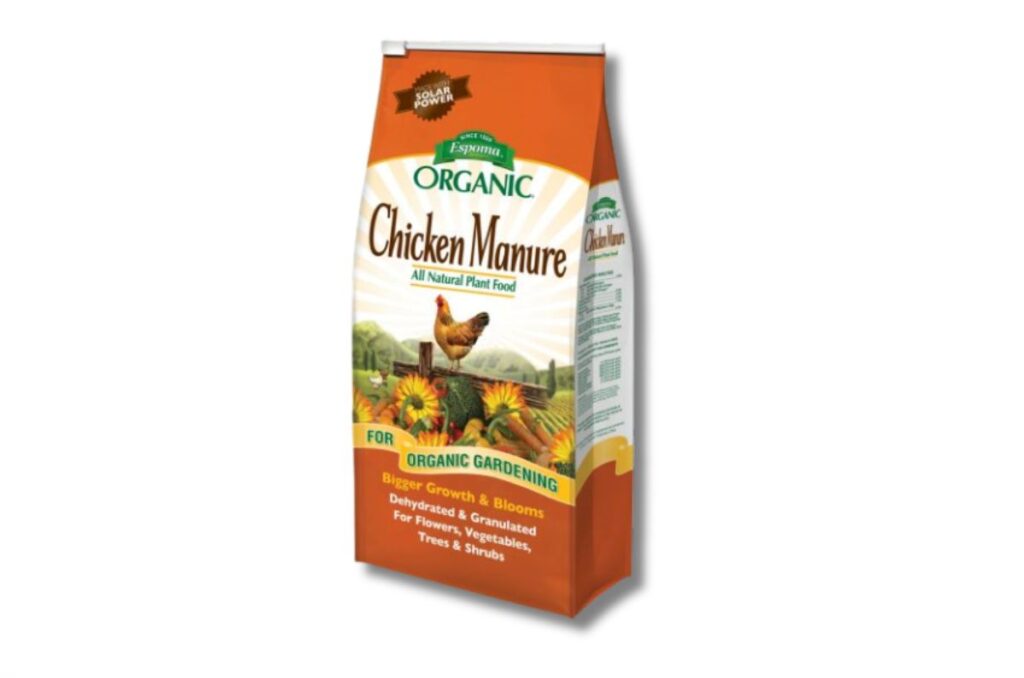
My Favourite Cucumber Fertilizers
Here are some of my favourite cucumber fertilizers:
These brands make really good fertilizers and I always recommend their products.
They’re also great for most other vegetables, so try them out in your garden.
When to Fertilize Cucumber Plants
There are 3 main times that you need to fertilizer cucumber plants
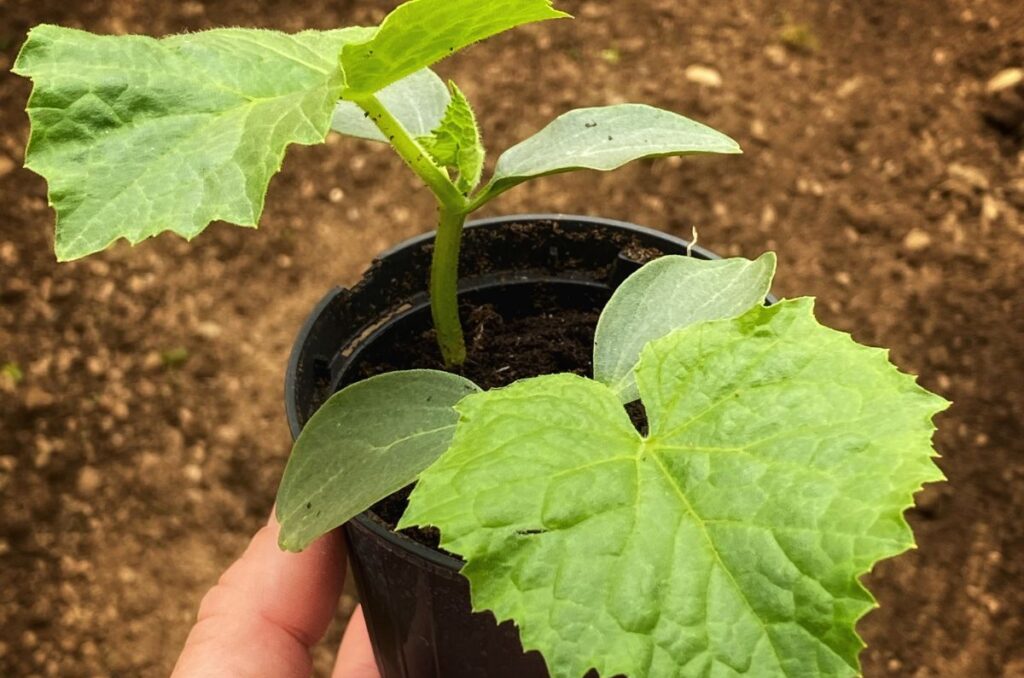
1. When They’re Seedlings
Yes, even small seedlings need fertilizer. A lot of beginner gardeners skip this part and they wonder why their seedlings’ leaves are yellow.
Cucumbers need to be fertilized when you start them indoors to give them the best chance to be healthy transplants.
Start fertilizing only after the first true leaves appear. If you fertilize as soon as they sprout, you might run into other seedling problems.
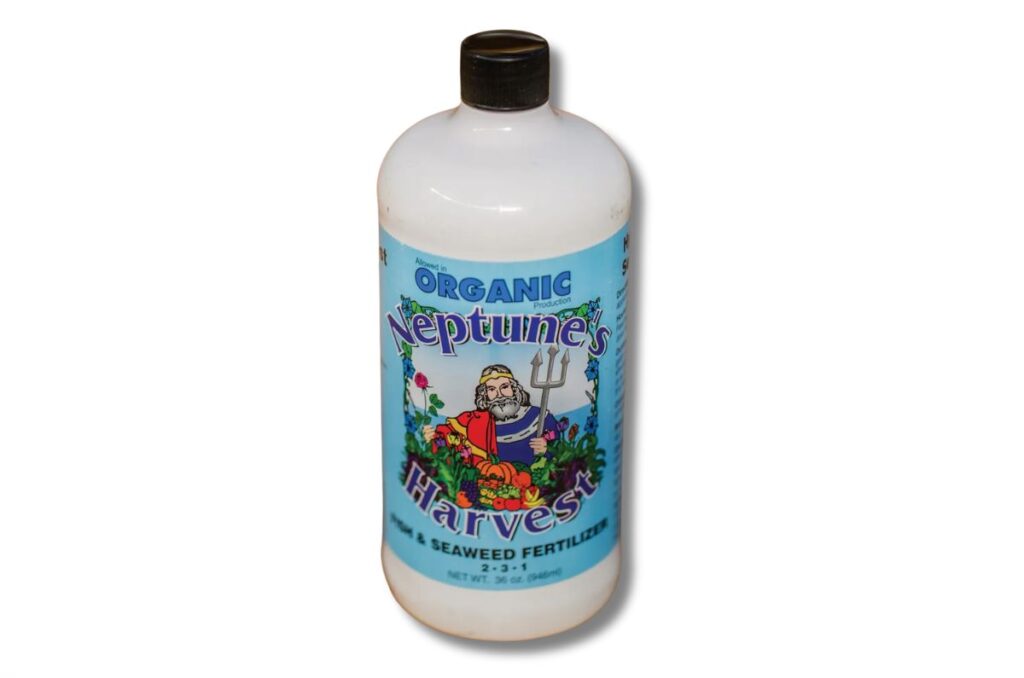
At this point, use a weak liquid fertilizer, like fish and seaweed emulsion. This has an NPK ratio of 2-3-1, so it’s perfect for small plants.
Additionally, use only half the recommended strength for seedlings. They don’t need that much fertilizer.
Any fertilizer with a low NPK ratio, like a 1-1-1 or 2-2-2, will be great for young cucumber seedlings.
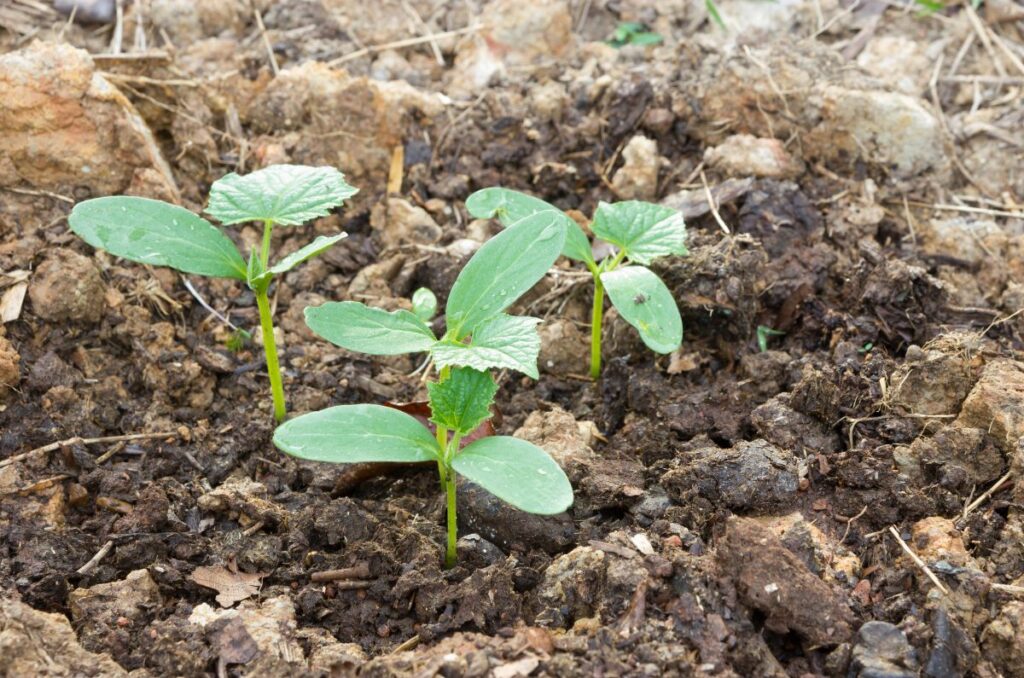
2. When Transplanting
Another great time to fertilize cucumbers is when you transplant them.
Put a generous pinch of granular fertilizer in the planting hole when fertilizing. This helps to promote more early season growth and reduce transplant shock.
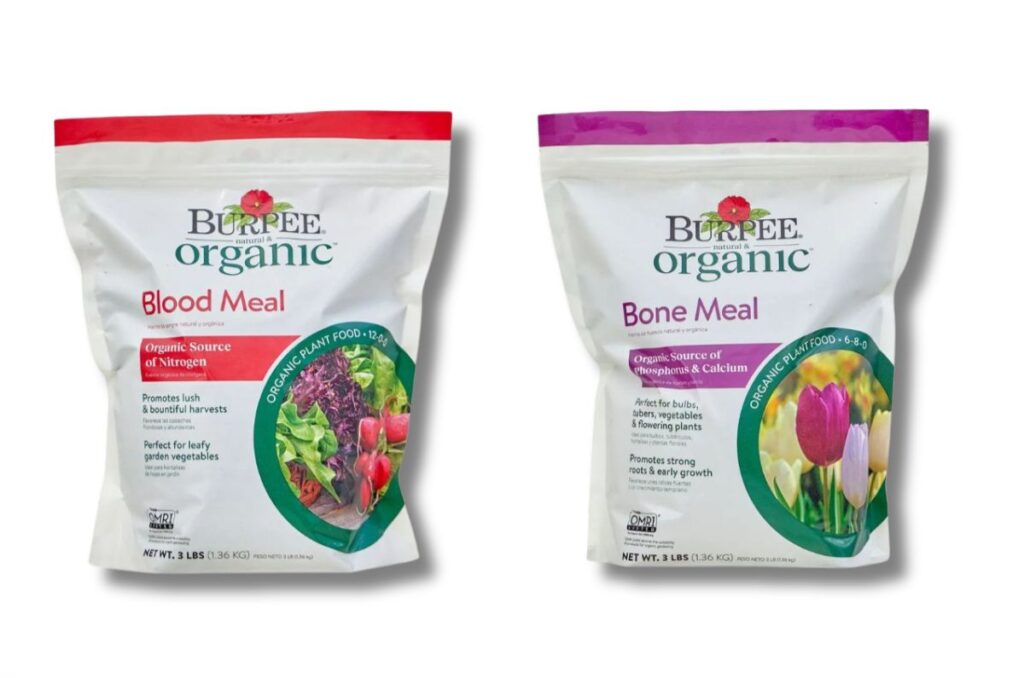
My favourite fertilizer is a mix of blood meal and bone meal. This gives your cucumbers enough nitrogen, phosphorus, and micronutrients to produce a ton of leaves and roots, which gets them ready for fruit production.
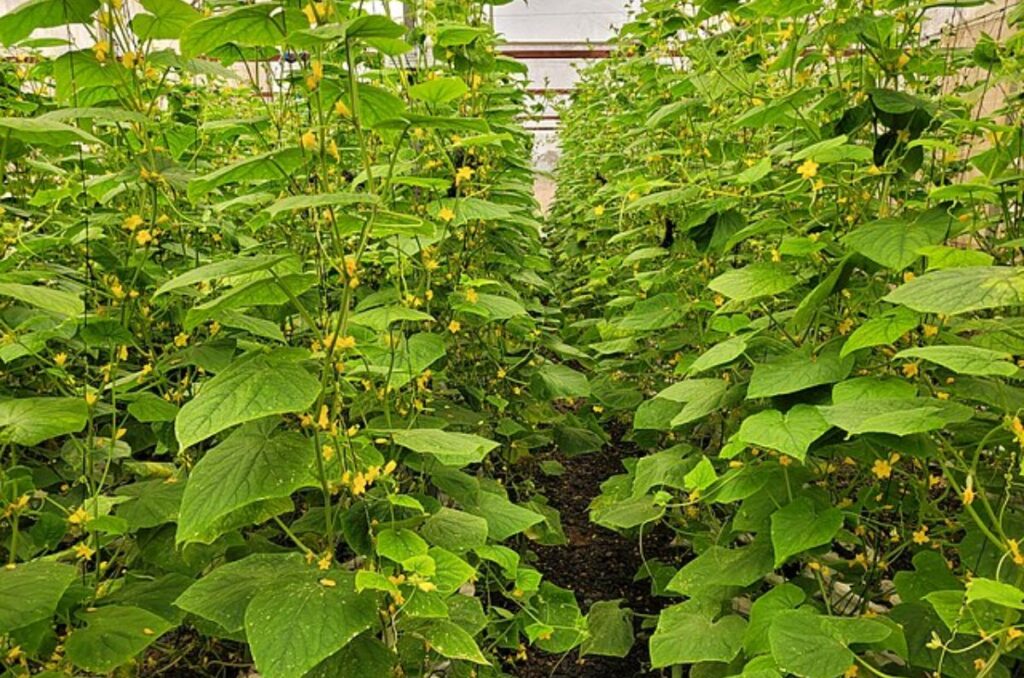
3. During Flower and Fruit Production
After the plants have been in the ground for about a month, then I’ll switch to a fertilizer with more potassium.
At this point, you should already have some flowers and the potassium will help to develop delicious fruits.
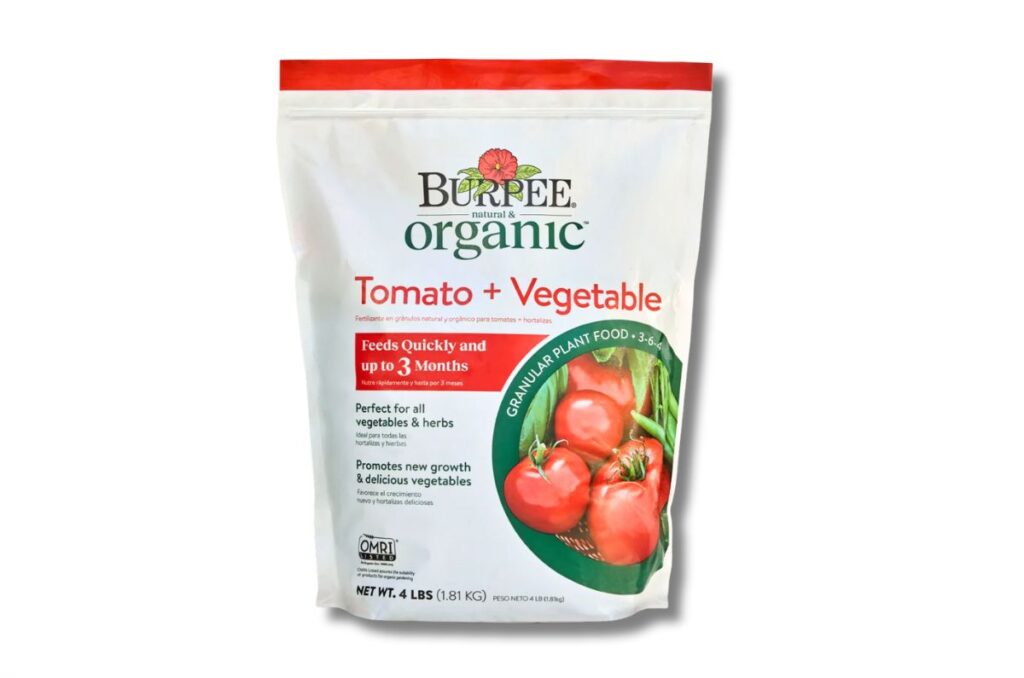
That being said, this Tomato + Vegetable fertilizer has an NPK ratio of 3-6-4, making it perfect for this time.
It’s great for all fruiting crops, like tomatoes, peppers, eggplant, and cucumbers.
To apply it, simply scratch it into the top couple inches of soil and water it in. The top feeder roots will have access to the broken down nutrients.
I know the package says it feeds for up to 3 months, but that’s usually only kind of true. A lot of it will get lost to runoff from watering and rain.
Instead, apply this fertilizer every 3-4 weeks during the growing season as the plants produce more fruit. This will give the fruits enough nutrients to be juicy and delicious.
Common Cucumber Fertilizing Mistakes to Avoid
Here are some of the most common mistakes that new gardeners make when fertilizing cucumbers:
- Too Much Nitrogen: You’ll get a ton of leaves and long stems, but you won’t get any good fruit. They need phosphorus and potassium as well, so don’t forget them.
- Fertilizing Dry Soil: Applying fertilizer to dry soil can burn your plants’ roots, which can stunt their growth. Instead, moisten the soil first with plain water, then apply your fertilizer.
- Ignoring Soil Health: You can’t fertilize your way out of bad soil. Dumping some artificial ingredients in your soil won’t do any good either. Prioritize soil health with compost and mulch, then add organic fertilizers.
- Fertilizing Too Late: Giving your cucumbers a ton of nutrients in late summer or fall will cause them to put out lots of new growth that won’t get anywhere. Fertilize early for early and delicious harvests.
Avoid these mistakes and you’ll have a bumper crop of delicious cucumbers.
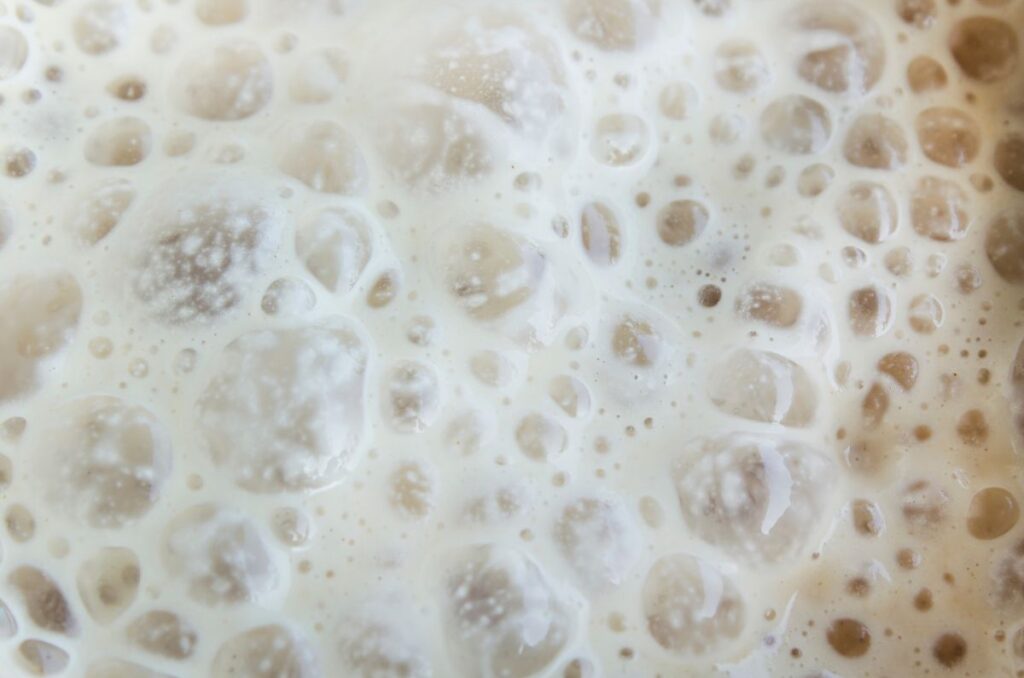
Can You Make a Cucumber Fertilizer With Yeast?
Yeast fertilizers are becoming really popular these days for their supposed benefits for your plants, especially cucumbers.
I have to say, I’ve never tried, but I still have to comment on it.
I’m not convinced that yeast fertilizer is a “fertilizer” in the traditional sense. It’s probably more of a soil amendment.
And I say that because there’s no actual nutrients in there; it’s just yeast and sugar.
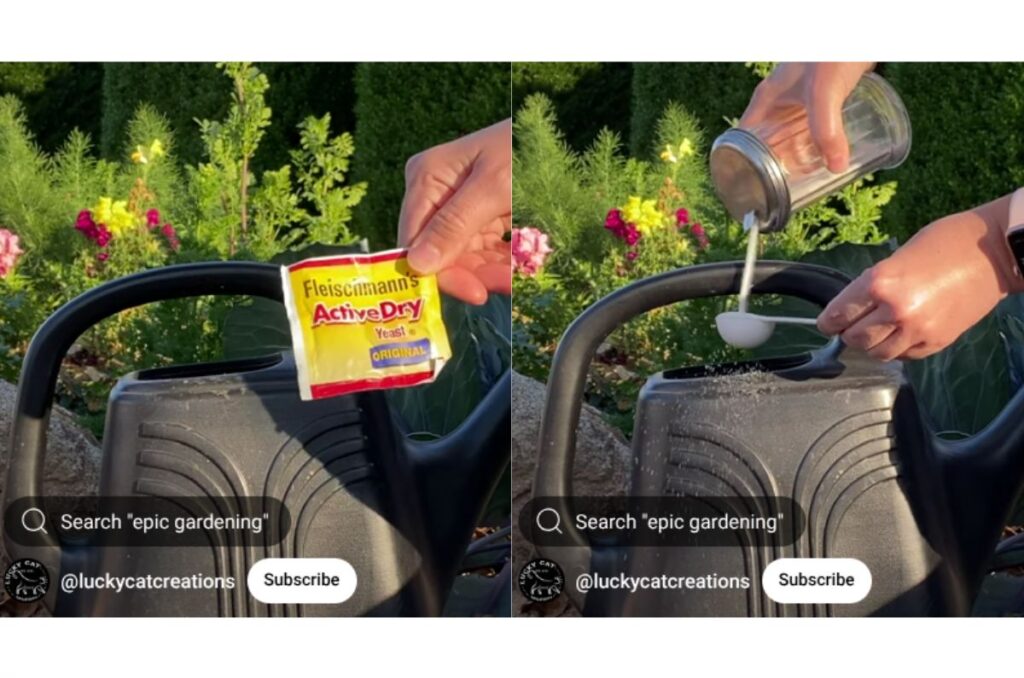
This video from Lucky Cat Creations shows how to make this “fertilizer.”
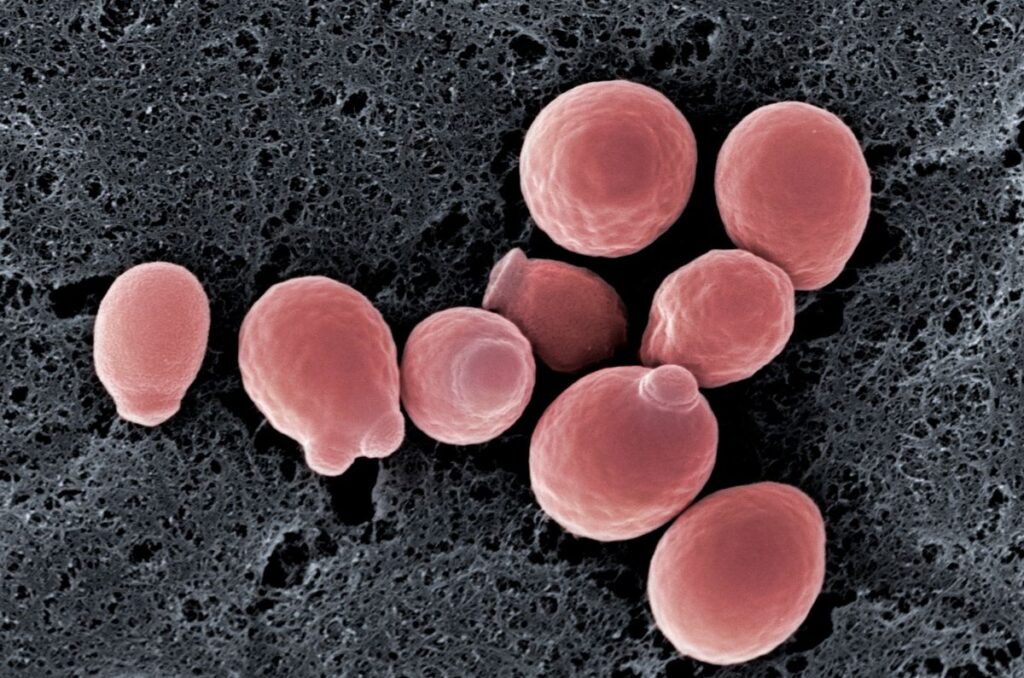
I think it’s more like compost tea, where it adds microbes to your soil, mainly yeast. It won’t do any actual fertilizing; you need nutrients for that.
So you can use it if you want, but it can’t replace cucumber fertilizer. I’ll have to try it this season to see if it does anything.
Using Milk as a Cucumber Fertilizer
Another gardening trend that’s becoming too popular is using milk to fertilizer vegetables. I don’t know why people do this.
Even if you dilute the milk with water. Even if milk adds tiny amounts of nutrients to your soil. Even if milk is on sale this week. Just why? Why would you use it as a fertilizer?
There are much better options for cucumber fertilizers that you don’t have to get at the grocery store.
Keep your milk in the kitchen and your fertilizer in the garden.
Frequently Asked Questions
Cucumber water fertilizer will do almost nothing for your plants. There’s no reason to use it as fertilizer, just eat your cucumbers.
Again, cucumber peels alone won’t do anything for your plants. However, you can add them to your compost or bury them in your garden as organic matter.
It might give the plants some magnesium and sulfur, but again, why would you? Most organic fertilizers are rich in these micronutrients already, so it really isn’t a problem.
Again, they won’t dramatically help or fix any fertility issues, but they can be a good addition to your compost pile. You can also bury them directly and get a nice boost of nitrogen in your garden soil.
Even More Gardening Ideas
Here are a few more posts to get the ball rolling in your garden!
- How to Grow Cucumbers from Seed to Harvest
- Best Organic Fertilizer for Vegetables that WORKS
- Compost vs. Manure: Which One’s Better for Your Garden?
If you liked this article, make sure to share it with your friends and family members who are also looking to sharpen their gardening skills. Also, consider signing up for our email newsletter; don’t worry, we won’t spam you, just fresh gardening ideas every week!
If you want to learn more about vegetable gardening, make sure to check out what I’m doing on Facebook, YouTube, and Pinterest.
Pin this post for later:
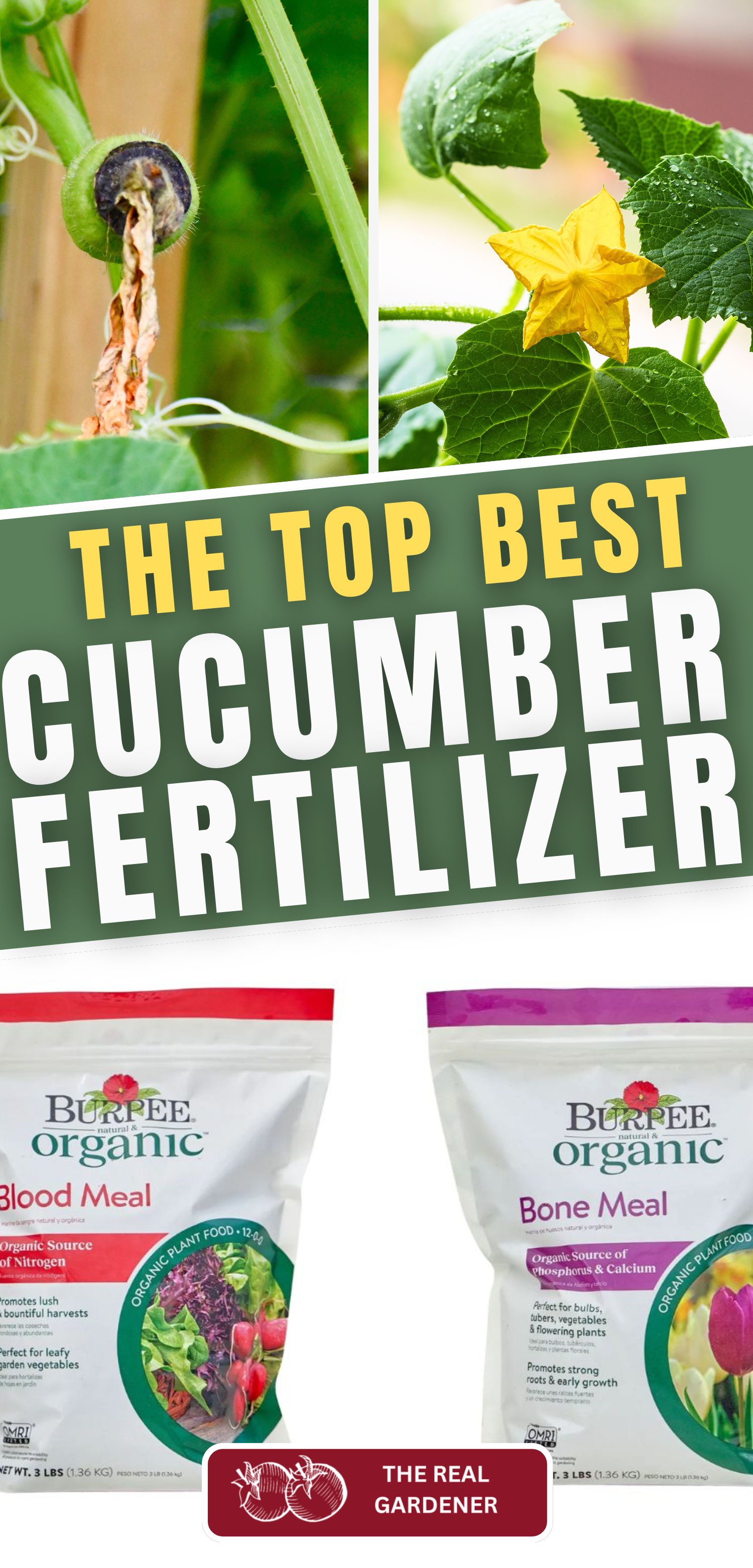
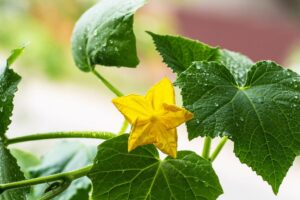
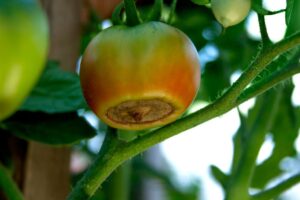



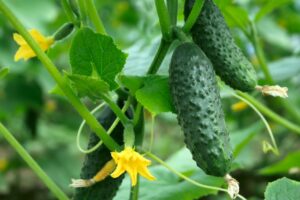
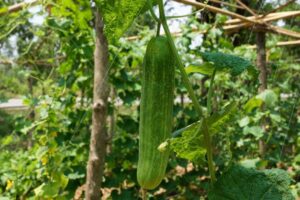

Leave a Reply